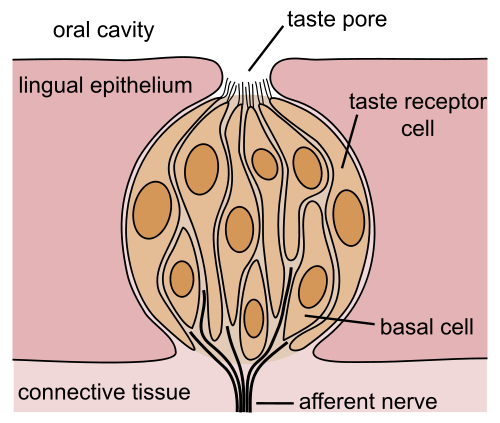Taste Buds (Human Tongue) and Sense of Taste (Sensation)
What are the taste buds?
The taste buds are the functional unit of the sense of taste. It is stimulated by certain chemicals in food and relays signals to the brain where it is perceived as the five taste sensations – sweet, salty, sour, bitter and . Odor (smell) and the texture of food can also alter the sense of taste. Apart from making the process of eating a more pleasurable experience and influencing the appetite, the sense of taste allows a person to select food base on the body’s nutritional needs.
The human tongue has between 3,000 to 10,000 taste buds. Each taste bud is about 0.03 millimeter in diameter and about 0.06 millimeter long. Children have the most amount of taste buds and after the age of approximately 45 years, many taste buds begin to degenerate.
Location of the Taste Buds
The taste buds are housed on the papillae of the tongue where taste receptors are able to detect different chemicals. There are other taste receptors on the palate, epiglottis and upper esophagus but it is the receptors on the tongue that are the primary organ of taste.
The taste buds are found on three types of tongue papillae :
- Vallate at the back of the tongue (posterior)
- Fungiform on the apex and body of the tongue (anterior)
- Foliate on the sides of the tongue (lateral)
The most numerous papillae on the tongue, filiform, do not contain any taste buds.
The taste buds distributed throughout the tongue play a role in detecting the different tastes although there are certain areas that are more sensitive for specific tastes. The posterior part of the tongue, which contains the largest number of taste buds, is sensitive to sour and bitter tastes. The apex of the tongue to sweet tastes while the sides (lateral) are sensitive to saltiness.
While most taste buds detect a single type of taste (salty, sweet, bitter, sour or umami), high concentrations of certain chemicals may excite two or more types of taste buds simultaneously.

Types of Tastes
The taste cells have varying number of receptors that are stimulated by several different elements and compounds, namely adenosine, chloride, hydrogen, inosine, potassium, sodium and glutamate. These chemicals will trigger the depolarization of the taste cell membrane. In addition there are specific receptors that detect bitter and sweet which indirectly trigger the depolarization by the action of secondary messengers.
This accounts for the five primary tastes – sweet, salty, sour, bitter and umami (also known as savory).
Below is a list of chemicals that are trigger certain taste sensations.
- Sour taste – hydrogen ions.
- Salty taste – ionized salts (anions and cations), especially sodium ions.
- Sweet taste – sugars, glycols, alcohols, aldehydes, ketones, amides, esters, some amino acids, some small proteins, sulfonic acids, halogenated acids, and inorganic salts of lead and beryllium.
- Bitter taste – organic substances, especially long-chain organic substances that contain nitrogen and alkaloids.
- Umami taste – foods containing l-glutamate.
The human tongue can perceive hundreds of different tastes which are just variations of these five primary tastes.
Structure of the Taste Bud

A taste bud is composed of specially modified epithelial cells known as taste cells (gustatory cells) which are surrounded by supporting sustentacular cells. The taste cells extend a number of small hair-like structures known as microvilli into a minute taste pore. These pores are the openings in the tongue that allow substances dissolve in the saliva to make contact with the microvilli.
How do taste buds work?
The microvilli are the receptor surface of the taste cells and responsible for detecting tastes. Food is dissolved in the saliva in the mouth and this solution is then able to slip into the pores where it stimulates the receptors of the taste cell microvilli.
When stimulated, ion channels on the taste cell open thereby allowing positively charge sodium or hydrogen ions to enter. The inner surface of the taste cell membrane, which is negatively charged, is depolarized by the influx of positive ions. The extent of the depolarization corresponds to the concentration of the substance that stimulates the specific receptor.
Vesicles within the taste cells release neurotransmitters from its inner surface which stimulate the surrounding network of nerve fibers. This discharges impulses which travel to and stimulate certain areas of the brain. This allows for the perception of taste.
Initially the rate of discharge increases till it peaks within a fraction of a second. It then adapts and the discharge rate decreases but continues thereby passing a weaker continuous signal until the substance is removed or the receptor accommodates. This is the reason why initially tasting a substance elicits the most prominent taste which subsequently decreases in intensity.
Taste Centers in the Brain
Food and substances dissolved in the saliva enter the taste pores where it makes contact with the microvilli of the taste (gustatory cells). This then triggers a depolarization of the taste cell membrane, a subsequent release of neurotransmitters and stimulation of the surrounding nerve fibers.
Signals from the nerve fibers of the taste buds travels via cranial nerves VII, IX and X to the tractus solitarius (gustatory area) located in the posterior brain stem. From here neurons transmit signals to the thalamus (ventral posterior medial nucleus). Third order neurons then carry signals to the postcentral gyrus in the parietal cerebral cortex (gustatory cortex).
Some taste signals that are transmitted into the thalamus trigger the salivatory nuclei which stimulate the salivary glands (parotid, submandibular and sublingual). This taste reflex is the reason for salivating when eating and why certain tastes trigger copious saliva secretion.

Taste and Appetite
The preference for certain tastes differs according to the body’s nutritional needs at the time, memories associated with certain tastes which is acquired through life and tastes that are culturally and socially acceptable. Negative experiences associated with certain tastes, like vomiting after eating too much of one food, will lead to an aversion for that specific type of food. Pleasant memories associated with certain tastes will lead to a preference for foods with these tastes.
Taste also influences appetite – it can stimulate the hunger center and satiety center. It is also the reason for certain cravings, like when the body needs certain compounds, a person will crave for food high in these substances. To the person, the craving is associated with taste. To the body, the craving is associated with the need for acquiring the substance in question.
Last updated on September 11, 2018.





